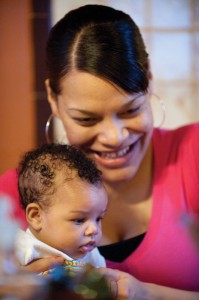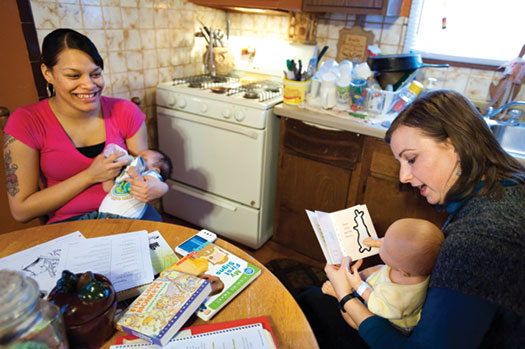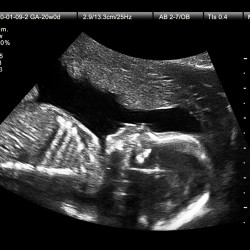Baby Steps

Krystal Jones holds her baby, Damani, and marvels at how quickly he’s growing. A special effort, the Healthy Birth Outcomes Initiative, is tackling a public-health crisis, hoping to significantly decrease infant mortality rates by the time Damani is old enough to be a parent himself. Photo: Jeff Miller
Infants in some Wisconsin communities are dying at shockingly high rates, but public-health experts are taking notice, pledging to make a difference family by family.
When Milwaukee public-health nurse Melissa Rader ’05 settled baby Damani Jones onto the scale in his grandmother’s kitchen in a little house on North Fourteenth Street, everyone smiled to see his weight at almost thirteen pounds.
“He’s growing so fast he’s already in six-month clothes,’’ says his proud mother, Krystal Jones, as Rader records the weight of the ten-week-old on her laptop computer. As part of the Nurse Family Partnership program, Rader has been visiting Jones at home since the twenty-year-old single mother was in her early pregnancy. Today, Rader will address a list of issues, from tips for breast-feeding while working, to the correct way to read books — such as the classic Pat the Bunny — to an infant.
There’s a somber reason for all of this loving attention. Baby Damani is up against some grim odds. African-American babies born in the 53205 zip code, and in some neighboring areas in Milwaukee’s inner city, are less likely to live to their first birthday than babies born in Jamaica, Sri Lanka, or Central America.
Put another way, some neighborhoods of Milwaukee, Racine, Kenosha, and Beloit have worse infant mortality rates for African-American babies than some Third World countries do for their entire infant populations.
In 2004, Wisconsin had the worst African-American infant mortality rate among the thirty-five states that reported deaths by race. That year, 125 black babies died in the first year following birth, a rate of 19.2 deaths per 1,000 births. While the rate has improved slightly since then, the death rate for black babies born in 2006 to 2008 was 15.2 per 1,000 births, compared to 5.9 for white babies.
African-American babies like Damani Jones are almost three times more likely to die during their first year of life than white children.
As shocking as these numbers are, most Wisconsin citizens are unaware of the problem.
“I have been a pediatrician for thirty-five years, and I’m embarrassed to say that I didn’t know the extent of it, either,’’ says Philip Farrell, professor of pediatrics and population health sciences, and former dean of the UW School of Medicine and Public Health. “These babies are truly innocent victims of a complex problem.”
To get a handle on the issue, the school commissioned a white paper report and held a summit at the Wingspread Conference Center in Racine in May 2008.
Dean Robert N. Golden says the school decided that this would be the focal point of its campaign to improve health in Wisconsin, and supported the Wisconsin Partnership Project’s decision to commit up to $10 million to improve infant mortality rates in four communities — an effort called the Healthy Birth Outcomes Initiative. (Project funds come from the $300 million the UW was entrusted with when Blue Cross Blue Shield United converted to a for-profit company in 2004; the Medical College of Wisconsin in Milwaukee received the same amount.)
“This is a public-health crisis for the state of Wisconsin,’’ Golden says. “From our perspective as the nation’s only combined school of medicine and public health, we believe this is a vitally important area where the combination of medical and public-health approaches can make a dramatic difference in the health of the state.”
While medical care focuses on caring for individuals, public health is concerned with the well-being of an entire community, and calls upon approaches including preventive medicine, education, and addressing underlying problems such as environmental pollution and poverty.
The Wisconsin Partnership Project funds the Nurse Family Partnership, a program that sends city of Milwaukee public-health nurses such as Rader into homes to counsel new moms. A Wisconsin Partnership study is also looking at why African-American infant mortality rates in Dane County dropped nearly 70 percent from the early 1990s to 2007, then unexpectedly shot back up again in 2008. And this is just the beginning of a long-term effort to make Wisconsin a healthier place for black babies.
The underlying issues are what make the problem so complex.
“Infant mortality is a baseline indicator of the health of a population,’’ says Farrell, who decided to put off his planned retirement in order to lead the UW’s effort.
Simply stated, babies are dying because neighborhoods such as the 53205 zip code, where Krystal Jones grew up, aren’t very healthy places to live. While residents might find several hospitals within a few miles, Farrell notes that “medical care is necessary, but not sufficient” — that additional issues such as pollution, poverty, and segregation make Wisconsin’s big cities unhealthy for African-American babies. Even when those factors are accounted for, middle-class, college-educated black women in Wisconsin are still more likely to have babies who die during their first year than white mothers who haven’t finished high school. Research suggests that the stress of racial discrimination and other traumas create biological changes that put both mothers and babies at risk for health problems.
Fortunately, there is evidence that the situation can be turned around. In Harlem, where infant mortality in 1990 was worst in the nation — nearly 28 deaths per 1,000 live births — a concerted effort dropped the death rate to about 5 per 1,000 within fifteen years. Mario Drummonds, of the North Manhattan Perinatal Project, has been to Wisconsin a number of times to talk about how organizations in that community began working together to improve the health of today’s mothers.
Wisconsin is also getting advice from Michael Lu, associate professor of obstetrics, gynecology, and public health at UCLA, who says the problem will never be solved by looking solely at the health care a mother receives during nine months of pregnancy.
“We used to think that if we could get women into optimal prenatal care, then we could close the gap,’’ says Lu. “Today we recognize that is probably expecting too much of prenatal care. If we’re serious about closing this gap, we must start taking care of women and families not only during pregnancy, but [also] before pregnancy, between pregnancies, beyond pregnancy, and across their entire life course.”
But even the best medical care in the country won’t help mothers who can’t get to it. Janette Strasburger, a pediatric cardiologist, recently experienced the barriers that keep some women from optimal health care when she was treating an African-American patient from southeastern Wisconsin whose fetus had an urgent heart problem. Strasburger practices with the Children’s Hospital of Wisconsin’s Herma Heart Center in Milwaukee and the Fox Valley; she sends high-risk patients to UW-Madison, where fetal heart rhythm problems can be imaged at the Biomagnetism Laboratory located in the new Wisconsin Institutes for Medical Research. It’s a one-of-a-kind facility, and pregnant women come from as far away as Florida and Hawaii so their babies can be monitored.

While Krystal Jones feeds her son in the kitchen of her mother’s home in Milwaukee, Melissa Rader, a public-health nurse, holds a baby doll to demonstrate how best to read books — including longtime favorite Pat the Bunny — to an infant. Photo: Jeff Miller
Getting her low-income patient to Madison for the assessment, however, proved a challenge that had Strasburger’s office staff on the phone for hours — eventually learning that the patient didn’t qualify for transportation for the disabled. Strasburger says the mother was “truly committed to the best care of her fetus within the constraints of her personal situation.” But even traveling to her high-risk obstetrics appointments in her hometown was a struggle. She didn’t have a car, she had two children under the age of three at home, and she could only have her mother babysit on the one day of the week that her mother didn’t work. Oh, and the bus that went to the doctor’s office ran just once an hour.
“I still have nightmares thinking about that young mother standing there on a cold snow bank in late December, waiting for a 7 a.m. bus to get her to her doctor’s appointment on the very day she delivered her baby,’’ Strasburger says.
But better transportation in poor neighborhoods is only one issue that impinges on health. Others range from better employment opportunities for young fathers to better grocery stores in the inner city.
“It’s going to be a long effort,’’ Farrell says. But the UW isn’t working alone. It’s joining many partners, including the state’s Department of Health Services, where Murray Katcher PhD’72, MD’75, a UW professor of pediatrics, is chief medical officer for community health. The state has launched a companion effort, Journey of a Lifetime, which emphasizes the “life course perspective” for improving the health of the next generation of parents beginning when they are babies.
“To improve the infant mortality rate is very complex,’’ Katcher says. “It requires social support; it requires a better ability for cross-cultural communication, and better health literacy of the population.”
One example of these efforts is the Safe Sleep campaign, launched last winter by the City of Milwaukee Health Department. Billboards — showing adult beds with tombstones as headboards and the words, “For Too Many Babies Last Year, This Was Their Final Resting Place” — are meant to drive home the message that infants are safer sleeping on their backs in their own cribs.
This spring the Wisconsin Partnership awarded planning grants to all four cities to set up partnerships to tackle public-health issues. Rather than create a competition between like-minded groups within the same city, the Wisconsin Partnership asked the groups to work together on a single community plan, bolstered by advice from a range of experts.
While people in Beloit, Racine, Kenosha, and Milwaukee are expected to craft solutions that fit their own communities, the efforts will be linked together and supported by Lorraine Lathen, hired as a senior adviser for the birth initiative. Lathen, who holds an advanced degree in international affairs, worked for USAID in West Africa on child and maternal health problems. She returned to Milwaukee to learn, much to her dismay, that her hometown was a less healthy place for babies than many developing countries.
“There are a lot of models the U.S. government was using in developing countries that we haven’t applied back home,’’ she says. “These include working with communities to find solutions that work in the context of people’s lives.
If we don’t, they’re not solutions.”
Making Milwaukee and other communities healthier places to grow up and give birth will take time, she says. “It can seem overwhelming, but the people in the trenches count the victories family by family.’’ The Healthy Birth Outcomes Initiative should be making short-term gains within five years, and a significant difference by the time babies the age of Damani Jones have grown up and become parents themselves. Improvements in infant mortality in Harlem and in Dane County show that community efforts can bring about significant change.
“This is really about reducing the health disparities in these communities,’’ Lathen says. “It’s about changing the lives of the people of Wisconsin. That’s what’s so exciting about this project.”
Susan Lampert Smith ’82 is a senior media specialist for UW Health Public Affairs.
Published in the Summer 2010 issue


Comments
Bob Merry August 31, 2010
It’s gratifying to see actions to save the lives of babies rather than the UW killing preborn babies.